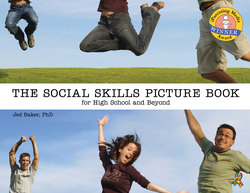Читать книгу The Social Skills Picture Book - Jed Baker - Страница 13
На сайте Литреса книга снята с продажи.
Оглавлениеxii
understand others, yet they may have great trouble with the flow of social conversation, talking
at
people instead of
with
people,
relaying factual information or phrases memorized from TV shows without responding to what their listener is saying or doing. Thus
individuals with Asperger’s may have extensive vocabularies, but difficulty using it in a fluid way to make conversation in social
situations. High-functioning individuals, like those with more language difficulties, may also have trouble with abstract language and
tend to interpret things literally. For example, if a teacher said, “Don’t let the cat out of the bag,” a literal interpretation would have
a student looking for a cat and a bag. In addition, many students with autism may have trouble processing language when there
are competing sights and sounds. Thus using language alone to explain complicated material may sometimes be less effective than
supplementing the explanation with concrete visual information that supports the verbal explanation (Quill, 1995).
Repetitive and ritualistic behaviors reflect a preference for sameness and repetition with regards to interests, daily routine, and
body movements. Many youngsters with autism develop a fascination with a particular area of interest and elaborate on that interest
to the exclusion of learning about new things. For example, I knew a youngster who became obsessed with vacuum cleaners and
was reluctant to attend to or talk about anything else. Many individuals with autism also exhibit nonfunctional routines that appear
superstitious in nature. One individual I worked with had to hang every picture in the house at a crooked angle before he could use
the toilet. Other students may not have nonfunctional routines, but prefer that their daily routines occur the same way all the time
and may become very anxious or upset when changes or transitions are introduced. Youngsters may also demonstrate repetition in
their use of language (repeating the same phrase over and over) or in their physical movements (e.g., repetitive hand flapping, body
rocking, or twirling around).
Because of the difficulties individuals with Autism Spectrum Disorders have in negotiating social situations and handling
changes in their environment, many students experience stress, frustration and anxiety on an almost constant basis (Kim, Szatmari,
Bryson, Streiner, & Wilson, 2000; Myles & Southwick, 1999). Wanting to interact with another student but not knowing how,
not understanding the change in teacher directions for a new challenging task, hearing other students laugh around them, and
not knowing whether they are the target of the joke—these are all stressful situations that youths with Autism Spectrum Disorders
experience daily.
Despite this level of stress, it is important to point out the emotional variability among students with Autism Spectrum Disorders.
Some students rarely seem to get upset, as they may handle their stress by withdrawal and go virtually unnoticed. Others present
with additional anxiety disorders (e.g., Obsessive-Compulsive Disorder, Social Phobia, or Panic Disorder). Some students seem to be
constantly frustrated, impulsive, and have frequent tantrums. Many of these individuals may also be diagnosed with Attention Deficit
Disorder or a Mood Disorder (e.g., Bipolar Disorder). Although students may react and cope with the stresses in their lives quite
differently, they may share a similar reason for experiencing high levels of stress, as described below.
